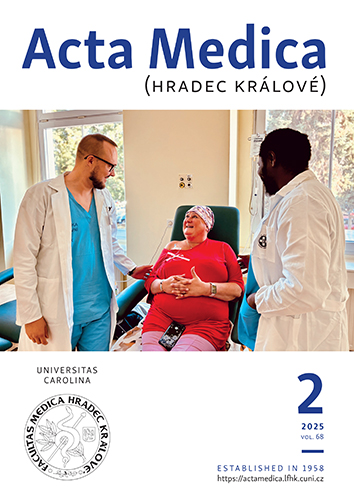ACTA MEDICA, Vol 64 No 3 (2021), 145–152
A Comparison of the Neuroprotective and Reactivating Efficacy of a Novel Bispyridinium Oxime K870 with Commonly Used Pralidoxime and the Oxime HI-6 in Tabun-Poisoned Rat
Jiří Kassa, Jana Hatlapatková, Jana Žďárová Karasová, Vendula Hepnarová, Filip Caisberger, Jaroslav Pejchal
DOI: https://doi.org/10.14712/18059694.2021.25
published online: 11. 11. 2021
abstract
Aim: The comparison of neuroprotective and central reactivating effects of the oxime K870 in combination with atropine with the efficacy of standard antidotal treatment in tabun-poisoned rats. Methods: The neuroprotective effects of antidotal treatment were determined in rats poisoned with tabun at a sublethal dose using a functional observational battery 2 h and 24 h after tabun administration, the tabun-induced brain damage was investigated by the histopathological evaluation and central reactivating effects of oximes was evaluated by the determination of acetylcholinesterase activity in the brain using a standard spectrophotometric method. Results: The central reactivating efficacy of a newly developed oxime K870 roughly corresponds to the central reactivating efficacy of pralidoxime while the ability of the oxime HI-6 to reactivate tabun-inhibited acetylcholinesterase in the brain was negligible. The ability of the oxime K870 to decrease tabun-induced acute neurotoxicity was slightly higher than that of pralidoxime and similar to the oxime HI-6. These results roughly correspond to the histopathological evaluation of tabun-induced brain damage. Conclusion: The newly synthesized oxime K870 is not a suitable replacement for commonly used oximes in the antidotal treatment of acute tabun poisonings because its neuroprotective efficacy is only slightly higher or similar compared to studied currently used oximes.
keywords: tabun; acetylcholinesterase; neurotoxicity; functional observational battery; histopathology; oximes; rats

A Comparison of the Neuroprotective and Reactivating Efficacy of a Novel Bispyridinium Oxime K870 with Commonly Used Pralidoxime and the Oxime HI-6 in Tabun-Poisoned Rat is licensed under a Creative Commons Attribution 4.0 International License.
210 x 297 mm
periodicity: 4 x per year
print price: 150 czk
ISSN: 1211-4286
E-ISSN: 1805-9694
